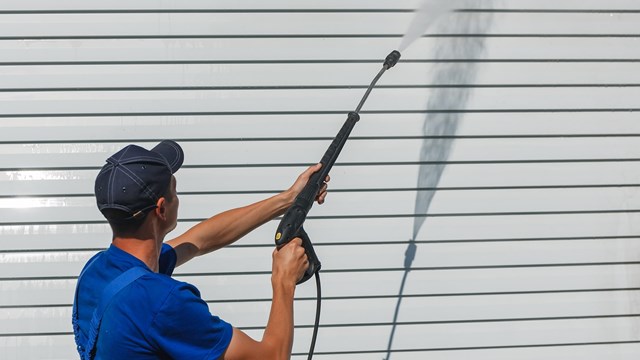Part of the appeal of HOA or condo living is living in an orderly, well-kept community where neighbors have agreed to uphold certain standards for their properties, the better to preserve value for all. For many, those standards include the aesthetic choices residents make for the exterior of their unit and its immediate surroundings—anything from window shutters to paint colors, mailbox placement to lawn ornamentation and holiday decor.
Looks Do Matter
Self-expression and creativity are basic human drives, and should be encouraged—but there’s a time and place for both, and as a rule, the outside of a condo unit isn’t it. Consider the visual chaos of having one door on a hallway painted hot pink, while another is festooned with multicolored LED lights, and a third sports the unit owner’s favorite NFL logo. Other residents might post political signs, or crowd the hallways with a jungle of houseplants, or put up oversized, motion-activated holiday decorations, or fly flags of all shapes, sizes, and fandoms, or leave their kids’ bikes and roller skates strewn about. What looks on-brand for an undergraduate college dorm doesn’t work quite as well for a building or association concerned with attracting buyers and upholding residents’ property values.
It can become a bit of a challenge to manage all of this, so to that end, most co-op, condo, and HOA governing documents spell out an array of do’s and don’ts for residents’ doors, windows, yards, and other public-facing elements of their units. But how can these rules be written to respect property rights and speech—and what happens when a resident fails to comply?
Fair & Enforceable
“Good and fair rules and regulations need to be enforceable and need to serve the community purposefully,” says Anthony Pisterzi, a community association manager with Association One, based in Bloomington, Minnesota. “We work with associations in drafting rules and regulations to address an issue that may arise; we always ask how the rule will be enforced, and whether the association has the right to enforce the rule. The rules and regulations must also meet the association’s spirit, design, and concept while not violating any ordinances or laws.”
For example, some boards limit exterior paint options to a pre-approved palette; some stipulate that holiday decorations must be of a certain size, or must be put up and taken down within a mandated time frame; others forbid kids’ bikes and toys from being left in front yards.
And of course, residents need to be made aware of the rules they’re expected to follow as members of the community. “New residents should receive a copy of the association’s governing docs that includes the declarations and bylaws, covenants and restrictions, as well as rules and regulations,” says Casey Olson, assistant property manager with PRG Property Management in Chicago. “The declarations and bylaws are more legal, whereas the rules and regulations are meant to be simplified.”
William Dyckman, high-rise community association manager at FirstService Residential in Chicago, explains that in his client buildings, there is a rule that allows for small religious artifacts to be affixed to the side of unit doors.
“Most residents do not have anything, but some residents put artifacts or rolled up scripture in their door frame,” he says. Aside from those items, “residents have full freedom of expression within the confines of their actual unit. But the common area, hallways, and unit doors are the property of the association, and are therefore under the governing documents.”
According to Olson, most condo associations have rules around displaying signs and flags on stoops, porches, and other public-facing exterior elements to maintain a cohesive, uncluttered appearance for the whole building or development. “For example,” he says, “if someone wants to hang their college flag, we would address that differently than a flag that might be deemed insensitive. It’s never easy, and it’s on a case-by-case basis.”
Pisterzi says that some rules—don’t put a giant LED fountain display that plays music in your front yard, say—are fair and justifiable, while others—a $100 fine each time a kid’s bike is left in the family’s own driveway, for example—can be pretty ridiculous. But “either way, violating them can result in both fines and acrimony,” he warns.
Unfortunately, some residents take umbrage at aesthetic rules and feel their freedom of expression is being infringed upon because they can’t fly their flags or hang their signs. “All buyers and potential new residents should be aware that some standards within associations may impact their perceived freedom of expression,” says Pisterzi. “These are critical factors when considering living in one community association versus another.”
Sometimes preventing issues with the residents comes down to explaining what’s allowed to the residents. Recently, Pisterzi had similar requests at two different associations for the installation of a sports flag.
“One association’s rules allowed the flag, and the resident was granted permission to install it at the entrance of their unit, while the other resident’s request was denied,” Pisterzi explains. “We made sure that the resident who was denied understood why the request was not granted. We went over the visual uniformity concept for the buildings. The resident understood, and decided to hang the flag in their office.”
Aesthetics = Value
Management pros—as well as realtors—say it’s important to think about how your building or association would look if the residents had completely free reign, and how it could affect the property’s bottom line when it comes to attracting buyers and setting sales prices. (Remember the college dorm comparison?)
Believe it or not, “property values are affected when people leave out their shoes, or decide to leave garbage in a hall to throw it away later when it’s against the rules,” says Dyckman. “Then you have a showing, and the people think those are the standards of the building and they may opt not to purchase there.”
“Associations that are not aesthetically appealing and do not maintain their curb appeal often see their property values impacted negatively,” agrees Pisterzi. “Conversely, when rules are enforced and the community is well maintained, a more desirable and a happier place to live is created.”
And setting visual standards and rules goes beyond just making a good impression on visitors and prospective buyers—it’s about safety too. “Safety takes precedence over aesthetics in high-rise buildings,” says Dyckman. For example, “if a resident puts something up that covers a unit number, how can we identify them in the case of a fire? Some decor can also be a trip hazard or a potential fire hazard, so we ask the resident to please remove it. If they don’t remove it, we send a violation.”
When it comes to holiday door decorations, Dyckman explains that the general rule in his client communities is ‘30 days before and 30 days after’ the holidays—meaning wreaths, lights, garlands, or whatever other decorations residents wish to put up can’t be displayed indefinitely. “Residents like that option and flexibility to make something special for their space without necessarily detracting overall from the aesthetic of the building,” he says. “We also allow the building to decorate the lobby and bring some seasonal warmth to the residents as they come in.”
Unfortunately, even with flexibility, Dyckman has had residents who do not comply with the rules. “If we get to that point, we levy a fine, and, if it’s a mat, for example, we will remove it and store it until a hearing is complete,” he explains. “Predominantly it seems that Ring doorbells with video recording are an issue because people want to feel safer, but it’s not uniform with the rest of the hallways. We’ve had to ask people to remove their cameras; if they don’t, we have to get legal counsel involved and explain they are in violation.”
Olson says that most residents comply when they are told that something goes against the governing documents and they are asked to remove it, “especially if they could potentially get fined for it,” he says. “But we’re always hoping that just talking to a resident prevents the problem from escalating. If the situation does get escalated, fines and violations are listed in the association’s governing documents that dictate how we would proceed.”
For a first offense, Pisterzi agrees that direct communication works best. “A phone call or a face-to-face conversation will go a long way,” he says. “If that is not possible, a courtesy letter with a gentle reminder encouraging compliance will usually do the trick. We find that first-time offenses are typically committed by new residents who are not yet familiar with the rules and regulations.”
If the issue persists, the association’s general counsel will get involved.
On the administrative side, Pisterzi reminds boards and managers to review their governing documents on a regular basis. “Be open to discussion of new ideas, and be creative when possible with enforcement mechanisms,” he says. “We encourage an annual review of the guiding documents to keep all residents aware of standards and keep the community harmonious.”
Additionally, Pisterzi says that when residents comply with the governing documents, the respect for the community is renewed. “We see less turnover of residents in community associations where conditions are maintained due to rule enforcement and standardization, which has a direct impact on property values,” he says. And that’s a good thing, no matter what your personal aesthetic.
Lisa Iannucci is a freelance writer and contributor to CooperatorNews.










Leave a Comment